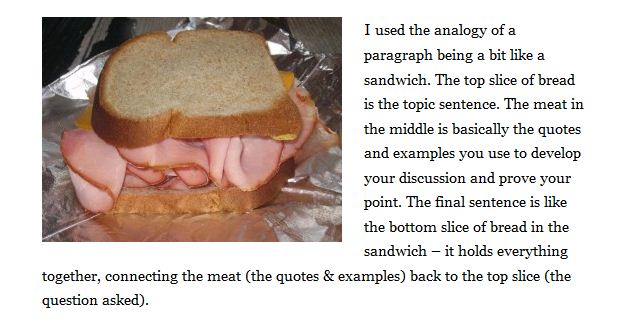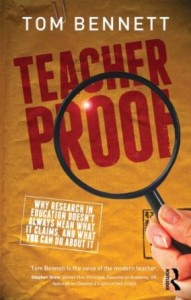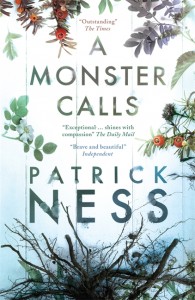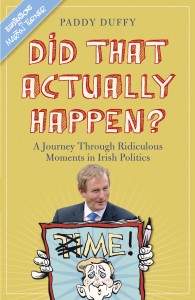Recently I’ve come to the very obvious conclusion that if a student can’t master the art of writing a really good paragraph they’ll never master the art of writing a really good essay.
This is such an obvious statement I’m almost embarrassed to type it publicly.
Anyway, I’ve started the Perfect Paragraph Project with my second and third years in an effort to help them master the art of the perfect paragraph so that they have the tools necessary to write a perfect essay.
Below are the advice and the example I’ve used to help them.
Topic sentence = introduce the idea you’ll discuss in this paragraph – this idea must be directly responding to the Q
Body sentences = 6-8 which go into more detail, using relevant quotes & examples to prove your point(s)t & offer your opinion(s).
Final paragraph sentence = connect what you’ve just said back to the question that was asked (but don’t repeat yourself. Think of this sentence as the sentence which shows what you have learnt / what you now understand).
Once we had established the basic rules for writing a perfect paragraph, I asked them to select a question – whatever one they wanted from their Christmas test – and I there and then created the paragraph below, talking through my thought process as I typed.
They could see what I was doing as it was projected up onto the whiteboard but I told them NOT to take it down as I didn’t want them to be distracted from the process. Then I left the sample paragraph on the board and they were then given 15 minutes to then create their own perfect paragraph. As I’m correcting them I’m trying to differentiate for the different difficulties (what a mouthful!) students are having and the hope is that practice will make perfect until everyone in the class is confident that they can write a perfect paragraph! That’s the theory anyway…
Sample Perfect Paragraph
In many ways I think I would not like to have Romeo as a boyfriend, mostly because he is an obsessive romantic who is in love with the idea of being in love. For example, Romeo maintains that he is love-sick and heartbroken following Rosaline’s rejection. One minute he believes that “love is a smoke made with a fume of sighs” yet the next minute he is proclaiming undying love for Juliet. In my opinion it would be difficult to believe anything he says because he is so fickle. Secondly he’s very superficial – he loves Juliet not for who she is but for how she looks, which is clear in his dramatic pronouncement “Did my heart love til now? forswear it sight, for I ne’er saw true beauty til this night”. This soppy, over the top attitude towards love is not my style – if he were my boyfriend I’d spend my time rolling my eyes at his compliments and wishing he would stop being such a drama queen.
PLANNING YOUR INTRODUCTION = first, brainstorm 4 or 5 ideas. Next, number these ideas in the order in which you intend to discuss them. Now, write your introduction – you basically offer your response to the question asked, then give a brief list of the things your essay will discuss. Basically each idea in your list then forms the basis of each paragraph.
JUNIOR CYCLE ONLY (you need 6 – 8 paragraphs for senior cycle)
Sample Introduction
In many ways I would not like to have Romeo as a boyfriend. He is very dramatic about love, he changes his mind continuously, he can be impulsive and violent and he is a very moody individual. However, there are moments where I do like him, particularly when he risks death to be with Juliet.
NOW I KNOW HOW THIS PERSON WILL STRUCTURE THEIR ESSAY – paragraph one will discuss his attitude to love, paragraph two will discuss his impulsive, violent side, paragraph three will discuss his moodiness & multiple proclamations that he’ll commit suicide if he can’t be with Juliet and paragraph four will attempt to offer some balance by discussing some of his finer qualities, including his bravery and his determination.
Conclusion checklist:
Recap your response to the question (re-phrase – don’t repeat introduction word for word)
Focus on how you felt & what you learnt
Sample Conclusion
Thus, although Romeo is brave and determined, on balance I would not like to go out with him. He is too dramatic, too sincere, too romantic, too moody and too impulsive for my liking and I suppose what I have learnt about myself from answering this question is that I would prefer someone altogether calmer and more grounded as a boyfriend.
























